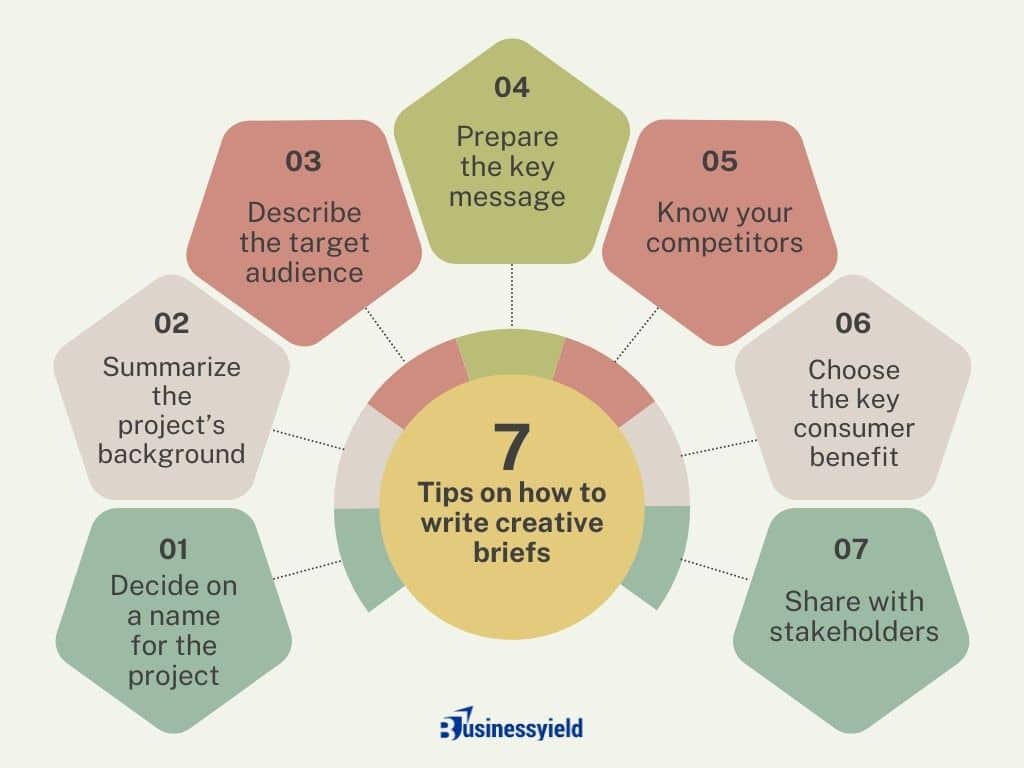Marketers love creative briefs. Why? Because it acts as a roadmap that takes the project from ideation to completion. It is the first step in any successful project that involves drawing up a game plan with a clear objective.
A creative brief puts into perspective the scope, timeline, key stakeholders, and purpose of the project, and ensures that they are communicated clearly. If questions come up or tasks become unclear, it will steer things in the right direction.
Imagine you want to build your dream house. You know what it will look like, you have the entire idea in your head, but you have no construction knowledge. Without architectural plans and blueprints, how would you explain your idea to a builder? You could describe what you want to the builder from now till kingdom come, but the chances of him getting the exact picture in your head are next to none.
That’s how it feels to work without a creative brief.
Key takeaways
A creative brief is an important document that outlines the key elements of a marketing, creative, or advertising project.
Some creatives say that it is the single most important indicator of whether a project will be successful or not.
A creative brief is typically filled out by your account manager or traffic manager after a face-to-face discussion with the client.
Taking the time to craft a detailed, inclusive creative brief will keep stakeholders aligned, the work focused, and the project on track for successful delivery.
What is a creative brief?
A creative brief is a short document that sums up marketing, advertising, or design project mission, goals, challenges, demographics, messaging, and other key details. It’s often created by a consultant or a creative project manager.
A creative brief:
- Gives all relevant teams and stakeholders visibility into project details
- Serves as an accessible reference point or central hub for high-level project info
- Keeps team members (including external and internal teams) on the same page as creative work progresses
This prevents various issues such as:
- Misunderstandings about project scope and goals
- Contributors acting independently, which can negatively impact the cohesiveness of the end product
- Confusion about who key stakeholders are or who is responsible for approvals
The goal of a brief is to achieve stakeholder alignment on a project before it begins.
How a creative brief works
Creative briefs are pretty standard documents within just about every marketing, advertising, or design team. For smaller projects that live in-house (like designs, templates, marketing assets, etc.) the brief is owned by the team who will be executing the information in the brief. This is usually the creative team, but this team can fall within the brand department or even live within marketing.
For more advanced, long-term projects that involve an agency, the creative brief is owned by the creative team or agency that will be executing the work. This is because they’ll work closely with the stakeholders on the project to understand what is needed, plus they’ll bring their own expertise and competitive research to the brief that the internal team may not have access to.
Elements in a creative brief
Before writing a creative brief, be sure to ask these 10 questions. Some are left out of briefs too often. However, believe it or not, covering these bases can make the difference between a struggling content project and a highly effective one.
1. Why are we doing this?
Anyone who wants to create anything worthy of publishing needs to know some context to the assigned project. They need to know:
- The ‘why’ of the project — what’s the need?
- What’s the pain?
- What’s the opportunity or challenge?
Your team may not need to know every nitty-gritty historical detail of the project, so don’t waste time trying to pin down every little thing. Only divulge what’s most important to your team.
2. Who is our target audience?
How will you know how to target your deliverables unless you know who will see, handle, watch, or read what you’re creating? Make sure you know the ‘who’ of the project before beginning. And I don’t just mean writing ‘potential customers.’ What about these potential customers?
- How old are they?
- Where are they from?
- What’s their average salary?
- What are their self-interests?
This type of information could be the difference between a successful campaign and a huge waste of time and money.
3. Who are our competitors?
After you’ve identified your target audience, include a list of your main business rivals in the brief. Add links to review what they offer and any similar projects to yours they have attempted. Consider:
- How did they do?
- What can you learn from them?
- Did they do a good job?
Finally, consider how you can differentiate yourself from them with your creative content.
4. What do you want us to deliver?
This is the client’s chance to tell you the ‘what’ of the project — what they actually want your team to deliver. This is where the client unveils their overall vision for the project. This can require a little digging, however, because often clients have a picture in their head of what they want.
If you can’t get them to describe that picture, the work your team completes, no matter how fabulous, can disappoint clients if it differs from their vision. This is the time to ask questions, get clarifications and manage expectations by communicating what expectations can or cannot be met and why.
5. What’s the big idea?
If this deliverable or campaign could be boiled down to a handful or less of key messages, what would they be? Some agencies call this the ‘big idea.’ What does this project most need to convey to, or evoke from, its audience?
6. How do we want it to look?
This section is especially important for external agencies that may have to learn a whole new brand with every project. This is where the ‘how’ gets answered, where you clarify the:
- Tone
- Color
- Font
- Size
- Logo specs
- Any other guidelines related to the project.
7. What is our core business objective?
Before we get into the work of shaping content, we need clarity on its reason for being. Unless it’s meeting a business objective, even the most dazzling projects can fail at its ultimate goal of creating value.
Discuss this thoroughly with your team and stakeholders at the outset, ensuring that creative projects aren’t just window dressing, but high-contributing parts of a larger strategy. Ultimately, when a creative asset is produced with the business objective in mind, defending aesthetic choices becomes easier.
8. Who are the stakeholders?
This also addresses the ‘who,’ but from the working side.
- Who will work on the project from the creative team?
- Who are the client’s decision-makers?
- Who should you go to for approval on drafts and in what order?
9. When is the deadline?
This is the ‘when’ of the project. Some of the key timings to ensure you confirm are:
- When is the start date?
- When is the final version due?
- What are the milestones?
- When are subtasks due?
- How many iterations are expected and by when?
When gathering this information, it’s important to determine what actions and dates are required of the client to keep the project on track. For example, do they only have two days to provide feedback without pushing back the deadline? This must be clearly defined from the beginning so the client will understand that any delays on their part will cause overall delays for the project.
You would be surprised how many creative briefs leave out these critical pieces of information, whether because the team is focused entirely on the deliverables or because they’re not asking.
Create an example timeline.
Create a timeline that looks something like this, working backward from when the content needs to be deliverable if possible.
- Kick-off meeting: Day 1
- Final creative brief due: Day 10
- Content due to client: Day 30
- Content due back from the client to action amends: Day 37
- Second review process: Day 40
- Upload online (or see proof in print): Day 42
- Publish: Day 45
- Measure success, govern and maintain: Day 45 onwards.
Remember, the content you’re creating ties into a campaign with concrete launch dates and your delivery date will become a critical component of its success. You need to know and be able to work with this project constraint, setting it out in the creative brief.
10. Where will this content appear?
Context is crucial in content. Different venues carry unique audience expectations and ways of engagement. You’d never, for example, write a print ad the same way you write a social post.
Where your content appears will determine its:
- Design
- Tone
- Style
- Size and scale
And how it moves users to the next point on the customer journey. Be sure to hone in on where your end user will engage with your final product.
Attached below is a template on how to write a creative brief. Note that you can edit as needed to suit your team’s preference:
Creative brief template
How to write creative briefs

Decide on a name for the project
The first step in developing a creative brief is deciding on a project name. This might sound simple, but it’s one of the most critical components of a creative brief. If you’re building a campaign around a brand-new product or service, the campaign name will be the first time many members of your team will be introduced to it.
Referring to the campaign (and therefore product or service) by the correct name prevents the game of telephone from happening. Without a specific and clear campaign name, people will make up their own terminology which can alter the intent of the campaign.
To create a project or campaign name for your creative brief, keep it creative and brief. A few words or a short sentence should work just fine. If you’re launching a product, identify what the call to action will be for the target audience, then center the name around that.
Write about the brand and summarize the project’s background
Another simple, yet essential section is the company background. If you work in an agency setting, this is non-negotiable as your team is likely handling several client campaigns at once. However, if you’re developing a creative brief for an in-house project, you’ll still want to include this part. New hires on your team, freelancers, and vendors will appreciate the background that your internal team is already privy to.
The company background shouldn’t be a general history of the company or a copied and pasted paragraph from the About page. Instead, tailor this to the project at hand. Set the scene with one or two sentences that sum up the brand’s mission. Follow this with a few sentences that give background on the brand and what led to the development of the project.
While some creatives have put this information all together in a quick paragraph, others separate it with headers like “Brand Statement” and “Background.”
Here are some questions to consider when writing a company background for your creative brief:
- Has the company launched a campaign like this before?
- Why is the company choosing to launch this campaign right now?
- How will this campaign respond to what’s happening in the market?
Highlight the project objective
Here is where the creative brief gets more specific. The project objective should briefly explain the purpose of the project, the timeline, and the audience it’ll target. This can be done in a sentence or two, but you can get creative and stylize it in sections.
This part of the creative brief will help emphasize why the project needs to happen. The goal aspects will help you and your team align with the project’s expectations. If the company or client hasn’t identified any major challenges, you can focus this section on goals and objectives. Explain what a successful project looks like and how it will benefit the company.
Describe the target audience
Next, it’s time to define the target audience for the project. This is the segment of your market that will directly benefit from the product or service being launched. You can take audience segmentation a step further by identifying a primary and secondary audience.
Doing so will give your team more freedom to explore creative ideas that might resonate with one group more than the other.
When crafting the target audience section, be sure to include the following:
- Demographics – Simple demographic information gives your team insight into exactly who the audience is. This includes data points like age, income, education, ethnicity, and occupation.
- Behaviors – Buying behaviors, trends, and other customer histories make up the target audience behaviors. These provide important context to the creative brief because they explain where the customer is in their buyer journey.
- Psychographics – This is how the audience thinks and feels about your brand and the product or service you sell, in general.
- Geographics – Digital, physical, and hybrid campaigns will benefit from having geographics stated explicitly in the creative brief so that media buyers can price ad slots in each market.
Prepare the key message
The key message can be the most difficult part of the creative brief to develop because just about every stakeholder will have a different opinion of what it should be. To get buy-in faster, try this simple trick. Ask yourself “We’re launching this project, so what?”
The “so what?” is your key message. It explains why your target audience should stop what they’re doing and pay attention to your campaign.
The key message includes the pain point, what the audience’s experience might be like without the pain point, and the benefit they’ll receive as a result of your company’s solution. This framework places the customer in the spotlight of the campaign. Instead of telling them what this product or service could do for them, it positions them as the main characters in the journey from problem to solution.
Interpret the competitive landscape
Knowing what your competitors are doing is advantageous for the whole team. You can use competitive data to come up with ideas that haven’t been tried yet, learn from their failed projects, or build a project that improves on a strategy they’ve used in the past.
Include a quick list of competitors with similar product or service offerings. Briefly list a few things your company has in common with them, how your brand has differentiated itself already, and a few areas where this project can help you get ahead.
Choose the key consumer benefit
If you’re launching a new product, there are likely several features and benefits that the target audience will experience when they decide to purchase it. However, it’s very difficult to structure a campaign around several different features. That’s why marketers and creatives use something called a key consumer benefit (KCB) in the creative brief to keep everyone aligned on the primary benefit being communicated.
To choose the right KCB, you’ll want to get input from the project stakeholders and rely on consumer data to guide the decision.
Determine the best call to action
Your audience needs something to do once they see your campaign. The good thing about CTAs is that they don’t have to be physical actions. A CTA could have a goal to change thoughts and perceptions about your brand which doesn’t require the audience to do anything at all.
Your creative brief might include several different CTAs, especially if you have a primary and secondary target audience. But it’s a good idea to have one primary CTA that drives the project objective we talked about earlier.
Once you’ve drafted a creative brief, share it with the team you’ll be working with. You’ll also want to circulate it around the company via Slack, email, or presentations. If you’re a consultant working outside of a client’s company, encourage your clients to share the brief internally.
As you or your clients spread awareness, you should be open to answering questions or taking feedback from colleagues in case they have any great ideas. This strategy will improve team alignment, increase support for the project, and ensure that all of your colleagues are on the same page.
Creative brief example
So what might a good creative brief look like? To give you a sense of what should be included, we’ve put together a quick example of a creative brief for a fictional company, TransformNation, which is launching a new product: a fitness-tracking app.
That brief might read as follows:
Project overview: TransformNation is launching a new fitness-tracking app aimed at encouraging individuals to adopt healthier lifestyles. This project involves creating a comprehensive marketing campaign to promote the app.
Objective: The objective of the marketing campaign is to generate awareness about the new fitness tracking app, drive app downloads, and encourage user engagement.
Target audience: Our target audience is a group of health-conscious individuals aged 18–35, who are tech-savvy and interested in tracking their fitness progress.
Unique selling proposition: TransformNation fitness tracking app not only tracks your physical activities but also provides personalized workout and diet plans based on your lifestyle, preferences, and goals.
Message: Empower your fitness journey with TransformNation — a personal fitness companion that adapts to your lifestyle.
Tone: The tone of the campaign should be motivational, empowering, and friendly.
Deliverables:
- Social media campaign: A series of engaging posts for Instagram, Facebook, and Twitter
- Email marketing: A planned sequence of emails to our subscriber list introducing the new app and its features
- Website content: A website update with new product information and promotional banners
- Blog posts: Three informative articles about the benefits of fitness tracking, encouraging readers to use our app
- Press release: An announcement to media outlets with all the key details of the new product launch
Timeline: The project should be completed within three months, starting from the first week of January to the end of March.
This is just a basic example of a fictional project. Of course, every brief will differ, depending on the project, its objectives, target audience, and the creative strategy. However, a few things should apply to every brief, regardless of the exact content and purpose — it should be clear, concise, and aligned with your project or strategic goals.
Who should write creative briefs?
A creative brief is typically filled out by your account manager or traffic manager after a face-to-face discussion with the client. As the name implies, a brief should be relatively short (think one to three pages) and give a solid overview of what was agreed on in the meeting. The person writing it should be able to demonstrate a high level of creativity and strategy.
If you still have questions, ask the client to clarify before you begin writing the brief just in case.
The decision on whether or not clients should have a say in a creative brief will depend on your organization, department, or team. However, you should weigh the pros and cons. If clients don’t have a say in creative briefs, your team runs the risk of wasting billable hours and your client’s time working on activities that don’t align with their needs or wants. If they do, you’ll have a better idea of what they want and how they’d like to approach the project.
Remember, a creative brief isn’t just about the end goal, it’s also about the process. If your client will need to approve key elements or would prefer to be more hands-on, the creative brief not only defines that but also lays the groundwork for your collaboration efforts throughout the project.
Creative brief vs. content brief: What’s the difference?
Content briefs and creative briefs differ primarily in scope.
Creative briefs contain instructions for producing a wide range of creative deliverables. They work for any creative project—not just written content. These briefs generally include different elements from the content brief. Details like company background information, campaign goals, key messaging, and brand statement(s).
Content briefs, on the other hand, help writers create content that matches marketing goals. Typically, they’re geared toward helping writers produce SEO-friendly content while covering the full scope of the topic.
Why are creative briefs important?
The value of having a creative brief is that it sets out to ensure that the deliverables from the creative project meet the client’s expectations and business needs. Because of their clear value in managing marketing and advertising projects, creative project managers typically employ them for each project.
Yes, a creative brief is just a document, but it’s an essential one. If you have a well-made creative brief at the front of your project, you’re less likely to have problems as you progress through the life cycle of the work.
Recommended Articles
- Selling Point: Strategies for Creating Strong Selling Points for Your Products
- Understanding the Impact of Recurring Revenue on Modern Businesses
- Sell Sheet: How to Create Effective Sheets (With Examples and Templates)
- 10+ Best Samples of Positive Feedback to Managers
- Empowering Efficiency: How Organizational Structure Impacts Your Business Growth






